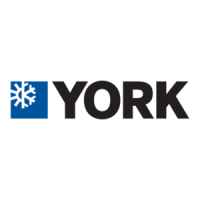130
YORK INTERNATIONAL
FORM 201.19-NM8 (804)
SYSTEM STARTUP CHECKLIST
JOB NAME: _____________________________
SALES ORDER #: ________________________
LOCATION: _____________________________
SOLD BY: ______________________________
INSTALLING
CONTRACTOR: _________________________
START-UP
TECHNICIAN/
COMPANY: _____________________________
START-UP DATE : _______________________
CHILLER MODEL #: ______________________
SERIAL #: ______________________________
COMPRESSOR #1
MODEL#: _______________________________
SERIAL #: ______________________________
COMPRESSOR #2
MODEL#: _______________________________
SERIAL #: ______________________________
COMPRESSOR #3
MODEL#: _______________________________
SERIAL #: ______________________________
COMPRESSOR #4
MODEL#: _______________________________
SERIAL #: ______________________________
UNIT CHECKS (NO POWER)
Check the system 24 hours prior to initial start.
# 1. Inspect the unit for shipping or in stal la tion
damage.
# 2. Assure that all piping has been com plet ed.
# 3. Check that the unit is properly charged and that
there are no piping leaks.
# 4. Open each compressor suction service valve,
discharge service valve, econ o miz er service
valve, liq uid line stop valve, and oil line ball
valves.
# 5. The compressor oil level should be main tained
so that an oil level is visible in ei ther of the two
oil sep a ra tor sight glass es. In other words, oil
level should al ways be main tained, run ning or
not, above the bot tom of the low er sight glass and
below the top of the upper sight glass.
Technical Data
If it is necessary to add oil, con nect a YORK oil
pump to the charging valve on the oil sep a ra tor,
but do not tight en the fl are nut on the delivery
tub ing. With the bot tom (suc tion end) of the
pump sub merged in oil to avoid en trance of air,
op er ate the pump until oil drips from the fl are nut
joint, al low ing the air to be expelled, and tight en
the fl are nut. Open the oil charg ing valve on the
oil separator and pump in oil un til it reach es the
prop er lev el as de scribed above.
# 6. Assure water pumps are on. Check and ad just
wa ter pump fl ow rate and pressure drop across
the evaporator.
Excessive fl ow may cause cat a stroph ic
dam age to the evaporator.
# 7. Check the control panel to as sure it is free of
for eign material (wires, metal chips, etc.).
# 8. Visually inspect wiring (power and control).
Wir ing MUST meet N.E.C. and local codes. See
Fig. 9 and 10, pages 34 and 35.
# 9. Check tightness of power wir ing in side the pow er
pan el on both sides of the motor contactors and
in side the motor terminal boxes.
# 10. Check for proper size fuses in main and con trol
cir cuits.
# 11.Verify that field wiring matches the 3-phase
pow er re quire ments of the compressor. See chill er
name plate (Pages 23 - 24).
# 12.Assure 115VAC Control Power has 30A min i mum
capacity. See Fig. 14, page 39.
# 13.Be certain all water temp sensors are in sert ed
com plete ly in their respective wells and are
coat ed with heat conductive compound.
# 14.Assure that evaporator EEV bulbs are strapped onto
the suction lines at 4 or 8 o’clock po si tions.
# 15.Assure that the 15 ton economizer TXV bulbs
are strapped onto the compressor econ o miz er
sup ply lines at 4 or 8 o’clock po si tions.
In actual operation, due to splash ing,
an oil level may be seen in both sight
glass es. Run the com pres sor for a few
min utes fully loaded, shut the system
down, and as sure there is an oil lev el
show ing in the bot tom or top sight
glass with the com pres sor off.

